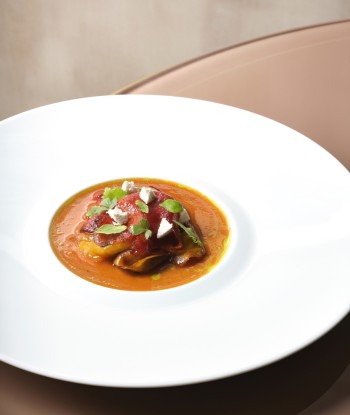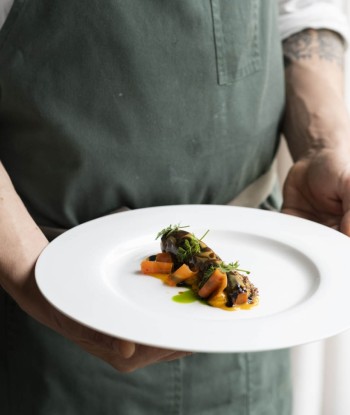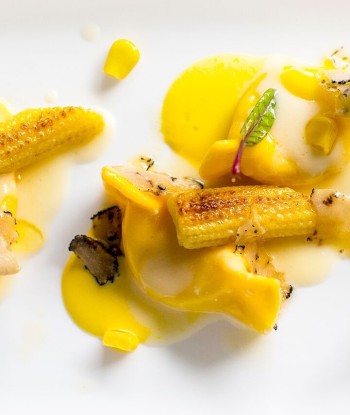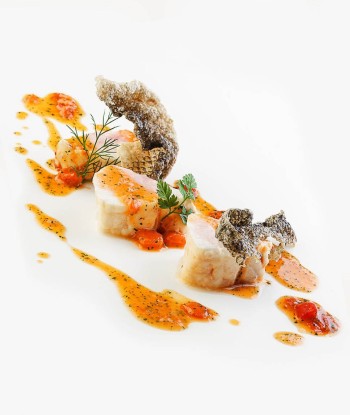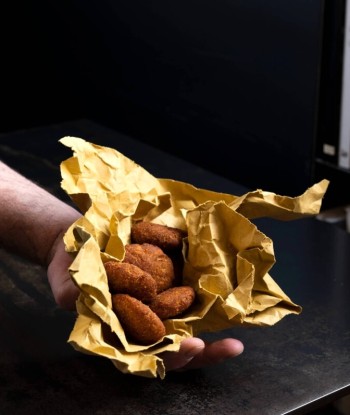From vegetable garden to plate: two-Michelin-starred chef Michelangelo Mammoliti presents a recipe that explores new frontiers of taste. Pomod'oro combines 3 varieties and 4 textures of one of Italy's most popular vegetables. A unique symphony on tasting.
POMOD'ORO
Initially created as a tribute to the artist Arnaldo Pomodoro, the Pomod'oro by the chef of the 2 Michelin Starred restaurant La Rei Natura by Michelangelo Mammoliti - located inside the 5*L Il Boscareto Resort & SPA in Serralunga d'Alba (CN) - is a vegetable dish, which aims to sublimate the organoleptic properties of this vegetable, without distorting it. In the recipe, the tomato is enhanced in three different varieties - ox-heart, red and yellow datterini - and in four textures: palet, coulis, gelatin and salmorejo. A recipe that demonstrates Mammoliti's great technical ability, as well as his ability to translate an inspiration into a dish. Salmorejo is in fact inspired by a trip made to Andalusia and the homonymous recipe typical of this region of Spain: a sour soup, served with Iberian ham and hard-boiled eggs. Two ingredients not present in Mammoliti's vegan version
Ingredients for 4 people
Per the tomato palet
- 400 g ox-heart tomato
- 10 g of extra virgin olive oil
- 5 g of powdered sugar
- 2 g of fine salt
- 2 g of thyme
- 2 g marjoram
- 1 clove of garlic
Method
Put the tomato in boiling salted water for 10 seconds and cool it in water and ice. Peel and cut the tomato in half. Season with oil, powdered sugar, salt, thyme, marjoram, and slivered garlic. Bake for 1 hour at 90°C in a ventilated oven.
For the red datterini coulis
- 1,600 g of red datterini
- 5 g of salt
- 50 g of extra virgin olive oil
- 10 g of basil
- 1 clove of garlic
Method
Put all ingredients together in a saucepan. Cook with the lid on for 20 minutes. Strain through chinoise and reduce by one-third
For the yellow datterini coulis
- 1,600 g yellow datterini
- 5 g of salt
- 50 g of extra virgin olive oil
- 10 g of basil
- 1 clove of garlic
Method
Put all ingredients together in a saucepan. Cook with the lid on for 20 minutes. Strain through chinoise and reduce by one-third
For the salmorejo
- 500 g red datterini
- 20 g of extra virgin olive oil
- 10 g of grape seed oil
- 5 g of salt
- 5 g red wine vinegar
- 5 g fresh oregano
- 5 g of thyme
- 1 clove of garlic
Method
Place all ingredients into a vacuum bag and let soak for 1 hour. Pass through a vegetable masher. Strain and store in the refrigerator.
For the tomato water jelly
- 150 g of tomato water
- 1 g fennel seed
- 1 g salt
- 6 g gelatin powder
Method
Toast fennel seeds, add tomato water and salt. Allow to steep 5 minutes. Strain and add the previously hydrated gelatin. Pour the gelatin into a small plate.
For the shiso pesto
- 50 g green shiso
- 5 g of extra virgin olive oil
- 1 g fine salt
- 1 g garlic
Method
In a mortar, place garlic with salt. Add the green shiso leaves and continue to pound. Finish with the oil and store in the refrigerator.
To finish
- To taste - Extra virgin olive oil, Maldon salt and basil leaves
Plating
Season the tomato palet with extra virgin olive oil and Maldon salt. Dress the two datterini coulis on top of the palet. Make a quenelle of shiso pesto. Break up the gelatin with a spoon and add it to the dish. Decorate with basil leaves. Serve the salmorejo on the side
Contact
La Rei Natura
Via Roddino, 21, 12050 Serralunga d'Alba CN
Phone: 0173 613042
Email: lareinatura@ilboscaretoresort.it


